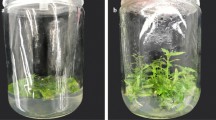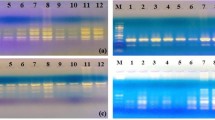Abstract
Our objectives were to improve the rate of haploid plant regeneration through increasing the rate of callus initiation on the anthers and sustaining shoot regeneration frequency, and to analyze the field population of anther culture origin by morphological and molecular methods. Regarding the callus initiation, the most responsive clones were ‘N-90’(59%) in P. nigra and ‘D-29’ (75%) in P. deltoides. The rate of shoot regeneration and number of shoots/calli ranged from 4%–79% and 1–9, respectively. From the 208 rooted plants 8 haploid, 179 diploid, 4 tetraploid and 17 aneuploid plants were found. In the field population, the haploid plants could be easily identified by their retarded development and morphological characteristics (size and shape of the leaves, strong branching, etc). Several diploid plants showed depressed developmental and morphological traits similar to the haploid ones. Three traits (growth rate, leaf blade length and shape of leaf base) of the 6 different morphological characteristics measured were in correlation with the ploidy level within the poplar field population. Six primers of the 48 primers tested were able to detect polymorphism among the field plants.
Similar content being viewed by others
References
Atanassov, A., N. Zagorska, P. Boyadjiev & D. Djilianov, 1995. In vitro production of haploidplants. World Journal of Microbiol & Biotechn 11: 400–408.
Bonga, J.M., 1977. Applications of tissueculture in forestry. In: J. Reinert & Y.P.S. Bajaj (Eds.), Applied and Fundamental Aspects of Plant Cell, Tissue and Organ Culture, pp. 93–108. Springer Verlag, New York.
Brown, P.T.H., E. Göbel, H. Lörz, 1991. RFLPanalysis of Zea mays callus cultures and their regenerated plants. Theor Appl Genet 81: 227–232.
Cervera M.T.,J. Gusmao, M. Steenackers, A.V. Gysel, M.V. Montagu & W. Boerjan, 1996. Application of AFLPTM-based molecular markers to breeding of Populus spp. Plant Growth Reg 20: 47–52.
Chen, Z., C. Quian, M. Qin, X. Xu & Y. Xiao, 1982. Recent advances in anther culture of Hevea brasiliensis (Muell.-Arg.). Theor Appl Genet 62: 103–108.
Heinze, B. & J. Schmidt, 1995. Monitoring genetic fidelity vs. somaclonal variation inNorway Spruce (Picea abies) somatic embryogenesis by RAPD analysis. Euphytica 85: 341–345.
Heinze, B.,1994. RAPD reactions from crude plant DNA. Mol Biot 1(3): 307.
Ho, R.H., A.Y. Raj, L. Zsuffa,1983. Poplar plants through anther culture. In: R.T. Eckert (Ed.), Proc. 28th North East Tree Improvement Conference. Univ. of New Hampshire, pp. 249–300.
Huhtinen, O. 1978. Callus and plantlet regeneration from antherculture of Betula pendula Roth. In: T.A. Thorpe (Ed.), 4th Int. Cong. Plant Tissue and Cell Culture. 20–25 August 1978, Univ. Of Calgary, Calgary, Alta., Canada, p. 169.
Huhtinen, O., J. Honkanenm & L.K. Simola, 1981.Effects of genotype and nutrient media on callus production and differentiation of Norway spruce endosperms cultured in vitro. In: Proceedings Colloque International sur la Culture In Vitro des Essences Forestieres. 31 August-4 September 1984, Fontainebleau, France. IUFRO Sect S2 01 5, AFOCEL, Nangis, France, pp. 307–311.
Kiss, E., J. Norelli, H. Aldwinckle & G. Hrazdina, 1995. Downregulation of ethylene biosynthesis in apples: Cloning and sequencing of partial ACC-synthase gene in McIntosh. In: Proceedings of the FAO/IAEA International Symposium on the Use of Induced Mutations and Molecular Techniques for Crop Improvement. Vienna, Austria, pp. 562–564.
Lin, D.C., M. Hubbes & L. Zsuffa,1997. Differentiation of poplar clones using random amplified polymorphic DNA fingerprinting. In: N.B. Klopfenstein, Y.W. Chun, M.S. Kim & M.R. Ahuja (Eds.), Micropropagation, Genetic Engineering, and Molecular Biology of Populus, pp 116–123. Gen Tech Rep RM-GTR-297. Fort Collins, CO: U.S. Department of Agriculture, Forest Service, Rocky Mountain Research Station.
Liu, Z. & G.R. Furnier, 1993. Comparison of allozyme, RFLP, and RAPD markers forrevealing genetic variation within and between trembling aspen and bigtooth aspen. Theoretical and Applied Genetics 87: 97–105.
Lloyd, G. & B.H. McCown, 1980. Commercially feasible micropropagation of mountain laurel, Kalmialatifolia, by use of shoot-tip culture. Proc Int Plant Prop 30: 421–427.
Millar, C.I., 1993. Conservation ofgermplasm in forest trees. In: M.R. Ahuja & W.J. Libby (Eds.), Clonal Forestry II. Conservation and Application, pp. 42–65. Berlin: Springer.
Mofidabadi, A., J. Kiss, K. Mázik-Tökei, J. Gergácz & L.E. Heszky, 1995.Callus induction and haploid plant regeneration from anther culture of two poplar species. Silvae Genet 44: 141–145.
Murashige, T. & F. Skoog, 1962. A revised medium for rapid growth and bioassays with tobacco tissuecultures. Physiol Plant 15: 73–97.
Munthali, M.T., H.J. Newbury & B.V. Ford-Loyd, 1996. Thedetection of somaclonal variants of beet using RAPD. Plant Cell Rep 15: 474–478.
Radojevic, L. 1978. In vitro induction of androgenic plantlets in Aesculus hippocastanum L. Protoplasma 96: 369–374.
Wang, Y.C.,Z. Chu & C. Sun, 1975. Induction of pollen plants of Populus. Acta Bot Sin 17: 56–62.
Zhu, X.Y.,R.L. Wang & Y. Liang, 1980. Induction of poplar pollen plants. Sci Silvae Sin 16: 190–197.
Author information
Authors and Affiliations
Rights and permissions
About this article
Cite this article
Kiss, J., Kondrák, M., Törjék, O. et al. Morphological and RAPD analysis of poplar trees of anther culture origin. Euphytica 118, 213–221 (2001). https://doi.org/10.1023/A:1004014601267
Issue Date:
DOI: https://doi.org/10.1023/A:1004014601267




